News & Updates
Lotus - A trusted name in family travel
Symbolic Foods for Chinese New Year
What gives a certain food symbolic significance? Sometimes it is based on appearance. For 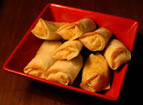 example, serving a whole chicken during the Chinese New Year season symbolizes family togetherness. Noodles represent a long life; an old superstition says that it's bad luck to cut
example, serving a whole chicken during the Chinese New Year season symbolizes family togetherness. Noodles represent a long life; an old superstition says that it's bad luck to cut  them.
them.
Both clams and spring rolls symbolize wealth; clams because of their resemblance to bouillon, and Spring Rolls because their shape is similar to gold bars.
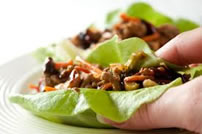 Or, food may have special significance during Chinese New Year because of the way the word sounds. For example, the Cantonese word for lettuce sounds like rising fortune, so it is very common to serve a lettuce wrap filled with other lucky foods.
Or, food may have special significance during Chinese New Year because of the way the word sounds. For example, the Cantonese word for lettuce sounds like rising fortune, so it is very common to serve a lettuce wrap filled with other lucky foods.
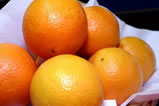 Tangerines and oranges are passed out freely during Chinese New Year as the words for tangerine and orange sound like luck and wealth, respectively. And let's not forget pomelos. This large ancestor of the grapefruit signifies abundance, as the Chinese word for pomelo sounds like the word for "to have."
Tangerines and oranges are passed out freely during Chinese New Year as the words for tangerine and orange sound like luck and wealth, respectively. And let's not forget pomelos. This large ancestor of the grapefruit signifies abundance, as the Chinese word for pomelo sounds like the word for "to have."
Fresh bean curd or tofu is not included as it is white and unlucky for New Year as the color signifies death and misfortune.
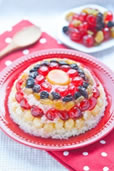 Here are a few traditional foods that are eaten during the two week holiday extravaganza, some with symbolic meaning and others incorporated simply for the delicious taste and tradition.
Here are a few traditional foods that are eaten during the two week holiday extravaganza, some with symbolic meaning and others incorporated simply for the delicious taste and tradition.
Eight Treasures Rice (contains glutinous rice, walnuts, different colored dry fruit, raisins, sweet red bean paste, jujube dates, and almonds).
"Tang Yuan" - black sesame rice ball soup; or a Won Ton soup. Tang yuan is a dish of glutinous rice balls served in a sweet broth. In Chinese cultur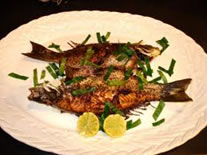 e, it is traditionally served on the winter solstice. By eating tang yuan, you welcome in the winter and become one year older.
e, it is traditionally served on the winter solstice. By eating tang yuan, you welcome in the winter and become one year older.
Chicken, duck, fish and pork dishes. Fish play such a large role in festive celebrations. The word for fish, "Yu," sounds like the words both for wish and abundance. As a result, on New Year's Eve it is customary to serve a fish at the end of the evening meal, symbolizing a wish for abundance in the coming year. For added symbolism, the fish is served whole, with head and tail attached, symbolizing a good beginning and ending for the coming year.
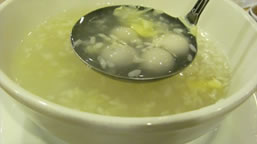 "Jiu Niang Tang" - sweet wine-rice soup which contains small glutinous rice balls. There are two typical kinds of soups. There is the usual tang yuan in brown sugar syrup tang yuan and the tang yuan with jiu niang , which is a kind of fermented glutinous rice popular in the Jiangsu and Zhejiang regions of China.
"Jiu Niang Tang" - sweet wine-rice soup which contains small glutinous rice balls. There are two typical kinds of soups. There is the usual tang yuan in brown sugar syrup tang yuan and the tang yuan with jiu niang , which is a kind of fermented glutinous rice popular in the Jiangsu and Zhejiang regions of China.
- "Song Gao", literally translates to "loose cake"- which is made of rice which has been coarsely ground and then formed into a small, sweet round cake. Or
 another popular desert eaten during Chinese New Year’s is Nian Gao (年糕). One of the reasons it's eaten during this time is because the words "nian gao (粘糕)", meaning "sticky cake," sounds just like the words 年高, which means something along the lines of "growing taller every year." Similar to "a pinch to grow an inch," this is just used to wish the person good health in the New Year.
another popular desert eaten during Chinese New Year’s is Nian Gao (年糕). One of the reasons it's eaten during this time is because the words "nian gao (粘糕)", meaning "sticky cake," sounds just like the words 年高, which means something along the lines of "growing taller every year." Similar to "a pinch to grow an inch," this is just used to wish the person good health in the New Year.
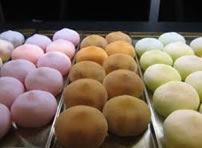 And what about the sweet, steamed cakes that are so popular during the Chinese New Year season? Cakes such as Sticky Rice Cake have symbolic significance on many levels. Their sweetness symbolizes a rich, sweet life, while the layers symbolize rising abundance for the coming year. Finally, the round shape signifies family reunion.
And what about the sweet, steamed cakes that are so popular during the Chinese New Year season? Cakes such as Sticky Rice Cake have symbolic significance on many levels. Their sweetness symbolizes a rich, sweet life, while the layers symbolize rising abundance for the coming year. Finally, the round shape signifies family reunion.
Sources: Thehistorychannel.com; Aboutfood.com; Wikihow.com; Chinesefood.com; Google images; Chinesesnacks.com and Yelp.